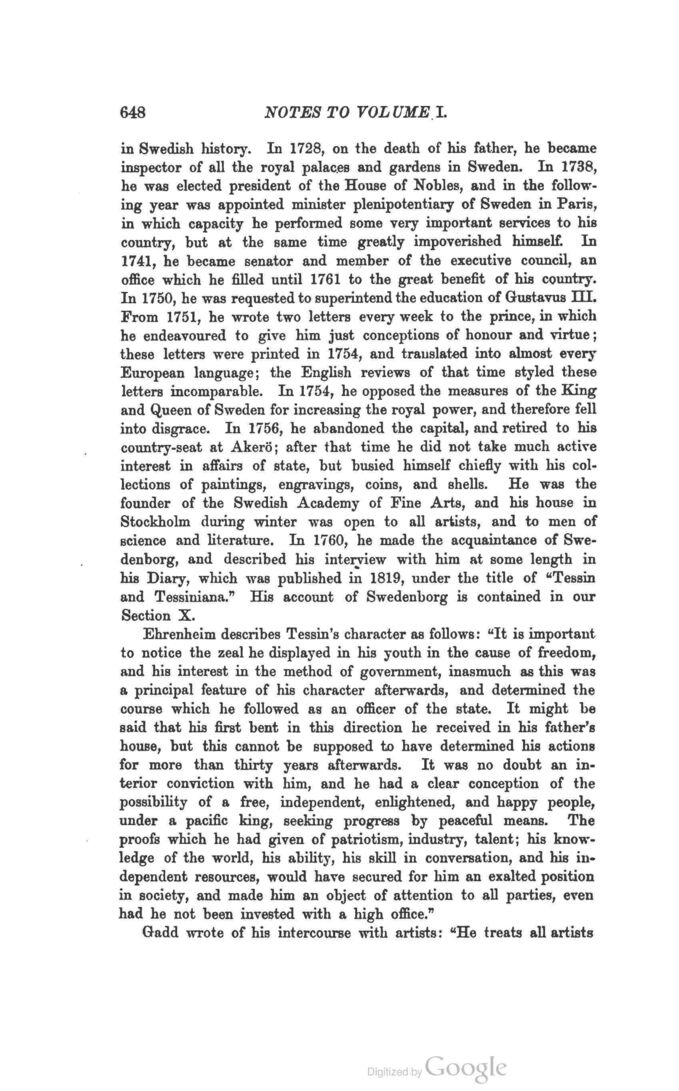
Full resolution (JPEG) - On this page / på denna sida - Sidor ...

<< prev. page << föreg. sida << >> nästa sida >> next page >>
Below is the raw OCR text
from the above scanned image.
Do you see an error? Proofread the page now!
Här nedan syns maskintolkade texten från faksimilbilden ovan.
Ser du något fel? Korrekturläs sidan nu!
This page has never been proofread. / Denna sida har aldrig korrekturlästs.
648 NOTES TO VOLUME I.
in Swedish history. In 1728, on the death of his father, he became
inspector of all the royal palaces and gardens in Sweden. In 1738,
he was elected president of the House of Nobles, and in the follow
ing year was appointed minister plenipotentiary of Sweden in Paris,
in which capacity he performed some very important services to his
country, but at the same time greatly impoverished himself. In
1741, he became senator and member of the executive council, an
office which he filled until 1761 to the great benefit of his country.
In 1750, he was requested to superintend the education of Gustavus III.
From 1751, he wrote two letters every week to the prince, in which
he endeavoured to give him just conceptions of honour and virtue ;
these letters were printed in 1754, and trauslated into almost every
European language; the English reviews of that time styled these
letters incomparable. In 1754, he opposed the measures of the King
and Queen of Sweden for increasing the royal power, and therefore fell
into disgrace. In 1756, he abandoned the capital, and retired to his
country-seat at Akerö; after that time he did not take much active
interest in affairs of state, but busied himself chiefly with his col.
lections of paintings, engravings, coins, and shells. He was the
founder of the Swedish Academy of Fine Arts, and his house in
Stockholm during winter was open to all artists, and to men of
science and literature. In 1760, he made the acquaintance of Swe
denborg, and described his interview with him at some length in
his Diary, which was published in 1819, under the title of " Tessin
and Tessiniana." His account of Swedenborg is contained in our
Section X.
Ehrenheim describes Tessin’s character as follows: “It is important
to notice the zeal he displayed in his youth in the cause of freedom,
and his interest in the method of government, inasmuch as this was
a principal feature of his character afterwards, and determined the
course which he followed as an officer of the state. It might be
said that his first bent in this direction he received in his father’s
house, but this cannot be supposed to have determined his actions
for more than thirty years afterwards. It was no doubt an in
terior conviction with him , and he had a clear conception of the
possibility of a free, independent, enlightened, and happy people,
under a pacific king, seeking progress by peaceful means. The
proofs which he had given of patriotism , industry, talent; his know
ledge of the world, his ability, his skill in conversation, and his in
dependent resources, would have secured for him an exalted position
in society, and made him an object of attention to all parties, even
had he not been invested with a high office.”
Gadd wrote of his intercourse with artists: “ He treats all artists
<< prev. page << föreg. sida << >> nästa sida >> next page >>